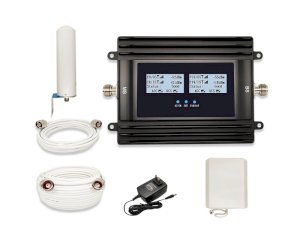
Living in a world where uninterrupted access to mobile services is guaranteed ubiquitously is truly convenient and enjoyable. But, has it ever occurred to you that heavy and sole reliance on the seamless operation of your mobile services isn’t a silver bullet at all? Perhaps, asking this question is the same as stating the obvious, but many people are still unaware of all the fuss, hazards, and predicaments that poor mobile connectivity may lead to. In an attempt to ensure robust network coverage in all possible scenarios, people can capitalize on two heroes of the modern age—Starlink and mobile signal boosters. But, if you happen to choose only one option, which of the contenders will win the battle of titans in the hope of being named as the best tool for improved connectivity? This is exactly what this article elaborates on.
phone signal booster LCD-300GD
+ FREE Lightning Surge Protector
for United States
4.9/5 — 278 Reviews
Starlink: an in-depth overview

Starlink is a brainchild of Elon Musk, the CEO of SpaceX. In essence, this technology stands as a satellite Internet constellation that can hypothetically provide global Internet coverage in addition to mobile broadband. Currently present in over 40 countries via 5,504 satellites placed in a low Earth orbit at about 550 km from the surface of the planet, Starlink delivers high-speed Internet with reduced latency estimated at 25 ms vs. 600+ ms. Taking advantage of this next-gen technology, users can complete a great number of activities, ranging from playing online games to making video calls to live streaming. Although Starlink exited beta testing in 2022 with an aim to expand globally at an unprecedented pace, it’s still under development and doesn’t operate a service in specific countries and regions. Like any bleeding-edge technology rolled out to the market, Starlink does both—brings tangible value to the table and presents certain risks to its users. But, before we scrutinize all these, let’s explore the concept of mobile boosters and how they operate.
Mobile boosters: deep dive
A mobile signal booster, or an amplifier, is a sleek, modern device that flaunts the extraordinary capability of capturing the weakest possible mobile signal from the closest cell tower and amplifying it considerably. The results of using this robust system are extended network connectivity, banished dead zones, and the possibility to enjoy stable and uninterrupted phone or video calls even in the most distant areas. Today’s signal booster market is booming, being abundant in systems that come in various types and serve different purposes. It’s possible to find GSM, 3G, 4G/LTE, and 5G amplifiers that operate at diverse frequencies, ranging from 700 MHz to 4000 MHz, and which are specifically designed for use either in buildings or vehicles. The reasons why people are massively investing in boosters are numerous, encompassing everything—from an urgent need to enjoy a stable and smooth connection in areas with poor network coverage to the anticipation of all sorts of incidents and emergencies. A worthy adversary of Starlink, a mobile signal booster is a valuable tool that will come in handy in both exhilarating moments and critical situations. But, is it going to defeat its rival on the battlefield? Let’s figure it out now!
Starlink vs. signal boosters: battle of titans
To understand the full picture of Starlink’s and amplifiers’ pros and cons, let’s scrutinize this comparative table:
| Starlink | Signal boosters | ||
|---|---|---|---|
| Pros | Cons | Pros | Cons |
| Quite fast, especially in remote and rural areas | Expensive: - hardware costs range from £225 to £2470; - monthly service costs vary from £74 to £4,864 |
Function flawlessly in both rural areas and cities | At least the weakest signal from the cell tower must be available for the amplifier to boost it |
| Reduced latency of 25 ms to 40 ms on average, but can increase depending on the region | Speed in large cities can be slower due to a high concentration of users | Operation is mostly unaffected by poor weather conditions | Limited coverage area, which depends on the model |
| No contract, 30-day free trial with the possibility of reimbursement | Unavailable in some countries and regions | A clear view of the sky is unnecessary to perform smoothly | - |
| The satellite dish is designed to withstand harsh weather conditions | Data caps—users are limited to 1 TB of data per month | Affordable fees for hardware that aren’t estimated in thousands of pounds | - |
| Can be used on the go, but requires premium plans | No installation services are offered to users and B2B customers | No need to invest in monthly service plans or subscriptions | - |
| - | A need for a clear view of the sky to operate properly | Easy to install, so even a complete novice can set it up | - |
| - | Service can be affected by poor weather conditions | Most vendors offer comprehensive installation services | - |
| - | Constant policy and price changes | A flexible return policy and money-back guarantee | - |
| - | Poor customer service | Round-the-clock customer service provided by most vendors | - |
Final verdict
Based on the aforementioned information, we can conclude the following:
- Starlink, despite being a next-gen technology that provides high-speed Internet with low latency, is more associated with negative rather than positive aspects. It requires ongoing investment, its performance hinges on the specific location and weather conditions, and its customer service leaves much to be desired as evidenced by multiple users. Its ever-evolving pricing models and policies in addition to a lack of installation services also repel prospective customers.
- Mobile signal boosters, on the other hand, operate perfectly in any place regardless of weather conditions. They don’t require substantial upfront investment in hardware and, most importantly, don’t involve any monthly subscription plans. They are also easy to set up, and if any installation issue arises, customer service is available 24/7 to support users. Even though amplifiers do need a weak signal to operate, and their coverage area is confined to some extent, their well-thought-out return policy and money-back guarantee outweigh these small nuances.
So, which titan has won the battle then?










